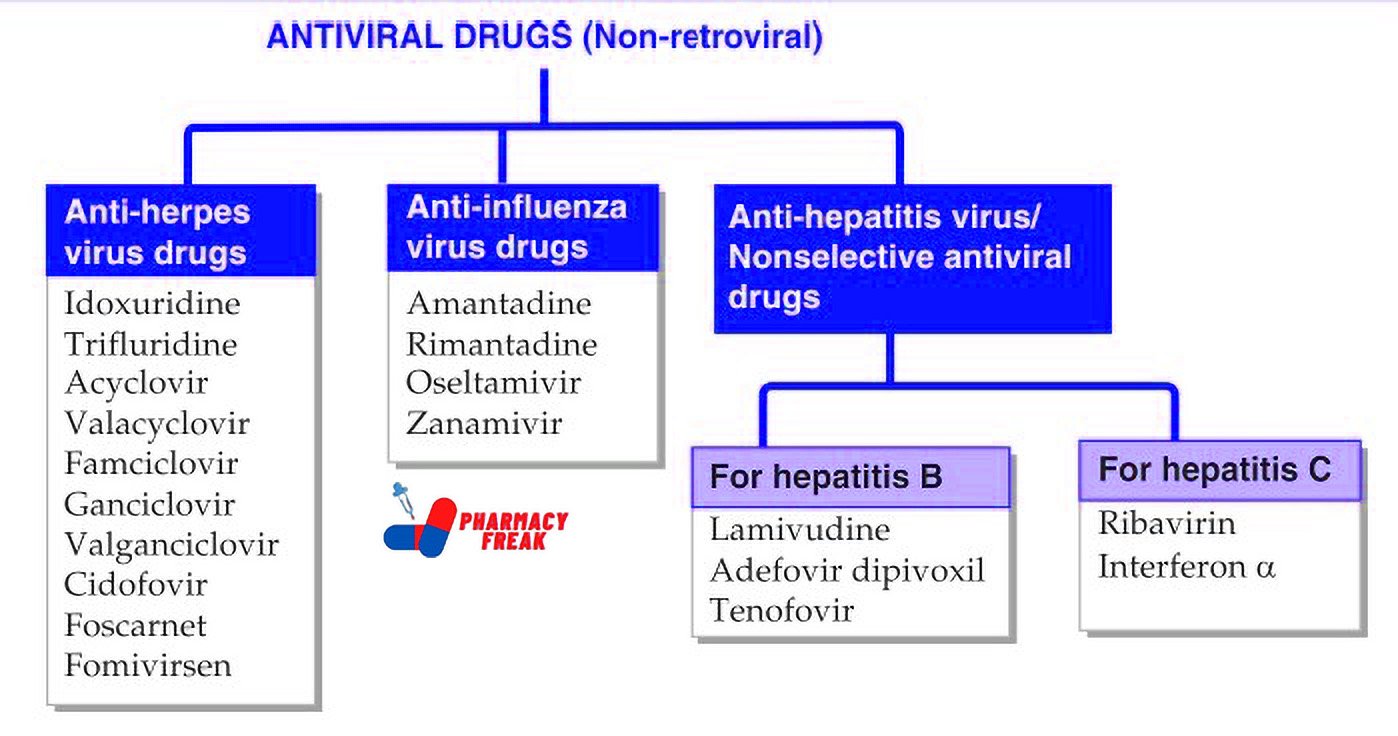Viral infections range from self-limiting to life-threatening illnesses. While vaccines prevent many viral diseases, antiviral drugs play a crucial role in managing active infections. Antiviral drugs for non-retroviral viruses work by inhibiting various stages of the viral life cycle, such as attachment, replication, or release. These drugs are specific to the virus and generally have limited activity against other types.
This blog from Pharmacy Freak explains the classification, uses, drug of choice, side effects, and clinical pearls of non-retroviral antiviral drugs.
Table of Contents
What is Antiviral Drug (Non-Retroviral)
Non-retroviral antiviral drugs are medications used to treat infections caused by DNA and RNA viruses other than retroviruses like HIV. These drugs inhibit viral replication by targeting enzymes or steps specific to viral replication.
Classification of Antiviral Drug (KD Tripathi)
- Anti-herpes virus drugs: Idoxuridine, Trifluridine, Acyclovir, Valacyclovir, Famciclovir, Ganciclovir, Valganciclovir, Cidofovir, Foscarnet, Fomivirsen
- Anti-influenza virus drugs: Amantadine, Rimantadine, Oseltamivir, Zanamivir
- Anti-hepatitis virus / Nonselective antiviral drugs
– For hepatitis B: Lamivudine, Adefovir dipivoxil, Tenofovir
– For hepatitis C: Ribavirin, Interferon α
Anti-herpes virus drugs: Idoxuridine, Trifluridine, Acyclovir, Valacyclovir, Famciclovir, Ganciclovir, Valganciclovir, Cidofovir, Foscarnet, Fomivirsen
Anti-influenza virus drugs: Amantadine, Rimantadine, Oseltamivir, Zanamivir
Anti-hepatitis virus / Nonselective antiviral drugs
– For hepatitis B: Lamivudine, Adefovir dipivoxil, Tenofovir
– For hepatitis C: Ribavirin, Interferon α
Classification of Antiviral Drug (General)
Antiviral drugs (non-retroviral) are classified based on the type of virus they act against:
- Anti-Herpes Virus Drugs
Acyclovir
Valacyclovir
Famciclovir
Penciclovir
Ganciclovir
Valganciclovir
Foscarnet
Cidofovir
Used in herpes simplex virus (HSV), varicella-zoster virus (VZV), and cytomegalovirus (CMV) infections - Anti-Influenza Drugs
a. Neuraminidase Inhibitors: Oseltamivir, Zanamivir, Peramivir
b. M2 Ion Channel Inhibitors: Amantadine, Rimantadine
Used for prevention and treatment of influenza A and B. M2 blockers are less commonly used due to resistance - Anti-Hepatitis B Virus (HBV) Drugs
Entecavir
Tenofovir
Lamivudine
Adefovir
Telbivudine
These inhibit HBV DNA polymerase and reduce viral replication in chronic HBV - Anti-Hepatitis C Virus (HCV) Drugs
a. NS3/4A Protease Inhibitors: Simeprevir, Grazoprevir
b. NS5A Inhibitors: Ledipasvir, Velpatasvir
c. NS5B Polymerase Inhibitors: Sofosbuvir, Dasabuvir
Used in combination regimens such as Sofosbuvir + Velpatasvir or Glecaprevir + Pibrentasvir to cure chronic HCV - Miscellaneous Antivirals
Ribavirin – Used for HCV, RSV
Palivizumab – Monoclonal antibody used in RSV prophylaxis
Interferons (IFN-α, IFN-β) – Used in chronic HBV, HCV, and some viral cancers
Uses
- Treatment of herpes simplex virus infections (genital herpes, encephalitis)
- Treatment of varicella-zoster virus infections (chickenpox, shingles)
- Cytomegalovirus infections in immunocompromised patients
- Seasonal and pandemic influenza
- Chronic hepatitis B and hepatitis C
- Respiratory syncytial virus (RSV) in children
- Post-exposure prophylaxis in transplant recipients and neonates
- Prophylaxis in high-risk infants for RSV
Drug of Choice Highlights
- Genital herpes – Acyclovir or Valacyclovir
- Herpes encephalitis – IV Acyclovir
- CMV retinitis – Ganciclovir or Foscarnet
- Influenza A and B – Oseltamivir
- Chronic HBV – Tenofovir or Entecavir
- Chronic HCV – Sofosbuvir-based combinations
- RSV in children – Ribavirin (aerosol), Palivizumab (prophylaxis)
- Herpes keratitis – Topical Acyclovir or Trifluridine
Side Effects
- Acyclovir – Nausea, headache, nephrotoxicity at high doses
- Ganciclovir – Bone marrow suppression, neutropenia
- Foscarnet – Nephrotoxicity, electrolyte disturbances, seizures
- Cidofovir – Nephrotoxicity, requires probenecid and hydration
- Oseltamivir – Nausea, vomiting, rare neuropsychiatric effects
- Amantadine – CNS stimulation, insomnia, hallucinations
- Tenofovir – Renal impairment, decreased bone mineral density
- Ribavirin – Hemolytic anemia, teratogenicity
- Interferons – Flu-like symptoms, depression, leukopenia
Updated Clinical Pearls
- Valacyclovir has better oral bioavailability than Acyclovir and is dosed less frequently
- Ganciclovir is more effective against CMV but has higher toxicity; Valganciclovir is its oral prodrug
- Foscarnet and Cidofovir are reserved for resistant CMV or acyclovir-resistant HSV infections
- Oseltamivir is most effective when started within 48 hours of symptom onset
- Tenofovir is preferred for HBV due to high potency and low resistance profile
- New direct-acting antivirals have transformed HCV into a curable disease
- Palivizumab is given monthly during RSV season in high-risk pediatric patients
References
- Tripathi KD. Essentials of Medical Pharmacology. 7th ed. New Delhi: Jaypee Brothers Medical Publishers; 2013. p. 894–902
- Gupta S, Garg A. Review of Pharmacology. 15th ed. New Delhi: Jaypee Brothers Medical Publishers; 2023. p. 306–308
- Brunton LL, Chabner BA, Knollmann BC, editors. Goodman and Gilman’s The Pharmacological Basis of Therapeutics. 12th ed. New York: McGraw-Hill Education; 2011. p. 1611–1625
Related Links

I am a Registered Pharmacist under the Pharmacy Act, 1948, and the founder of PharmacyFreak.com. I hold a Bachelor of Pharmacy degree from Rungta College of Pharmaceutical Science and Research. With a strong academic foundation and practical knowledge, I am committed to providing accurate, easy-to-understand content to support pharmacy students and professionals. My aim is to make complex pharmaceutical concepts accessible and useful for real-world application.
Mail- Sachin@pharmacyfreak.com
